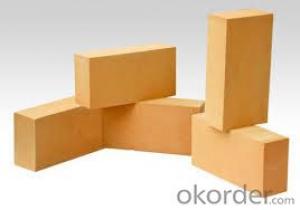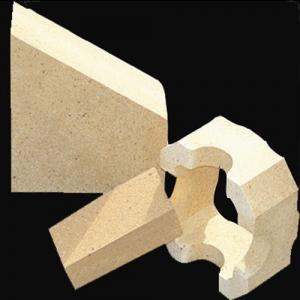High Quality Fireclay Brick
- Loading Port:
- China Main Port
- Payment Terms:
- TT OR LC
- Min Order Qty:
- -
- Supply Capability:
- -
OKorder Service Pledge
Quality Product, Order Online Tracking, Timely Delivery
OKorder Financial Service
Credit Rating, Credit Services, Credit Purchasing
You Might Also Like
CMAX fireclay bricks are made from clinker clay. The alumina content ranges from 36% to 48%.
Quick Details
| Place of Origin: | Shape: | Material: | |||
| SiO2 Content (%): | Al2O3 Content (%): | MgO Content (%): | |||
| CaO Content (%): | Refractoriness (Degree): | CrO Content (%): | |||
| SiC Content (%): | Model Number: | Brand Name: | |||
| Color: | B.D.: | Porosity: | |||
| CCS: |
Packaging & Delivery
| Packaging Detail: | wooden pallet |
| Delivery Detail: | within 20 days |
Specifications
red clay brick
1) Good thermal shock resistance
2) High-temperature endurable
3) Good thermal insulation
- Q: What material is sk-34 on the refractory brick
- Electric power; refractory bricks, castable refractory, building materials, chemical, glass, ferrous metals and other industries required refractory and insulation materials, all kinds of thermal insulation cotton products, thermal insulation brick, aluminous refractory cement, perlite and other unshaped refractory materials have been the best-selling products
- Q: What's the difference between a high aluminum brick and a clay brick, two?
- Lightweight high alumina bricks are usually made of high alumina bauxite clinker with a small amount of clay. After grinding, the bricks are poured and shaped in the form of slurry by gas or foam method. They are fired at 1300~1500 DEG C. Sometimes industrial alumina can be used instead of some bauxite clinker. Used for lining and insulation of masonry kilns, as well as for areas where there is no strong, high temperature molten material erosion and erosion. When contacting the flame directly, the surface contact temperature shall not be higher than 1350 degrees centigrade.
- Q: What kind of material is good to be laid on the kiln car, refractory brick?
- It depends on the temperature. General thermal insulation brick is ok, when temperature is high, use mullite, and when temperature is not high, alumina is ok
- Q: What is the meaning of special shaped refractory brick material n-2b?
- In fact, there are many kinds of refractory bricks, titanium, high alumina refractory brick, after drying. The mineral composition of the clay brick is mainly kaolinite (Al2O3·2SiO2·2H2O) and 6% ~ 7% impurities (K, etc.). Clay refractory bricks are iron oxide sintered by 50% soft clay and 50% hard clay clinker ingredients according to a certain granularity requirements under the high temperature of 1300 ~ 1400 degrees), perlite
- Q: Can refractory be used to sharpen knife?
- Many factories build a smelting furnace by using this kind of bricks. A special knife grinder can be used to sharpen knife, can on 1. They are sizing and non-sizing refractory bricks respectively. Refractory brick is now a lot of fields and industry will introduce one of the raw materials. Products are divided into two different types, refractory brick as a high temperature resistance of the raw materials. In simple terms, working temperature is 770 DEG C, 580 C and 1, of course, refractory bricks also can be used to sharpen knife, use smooth brick to sharpen, need to choose high hardness
- Q: What is the difference between a clay brick and a red brick?
- Clay bricks burn red and red brick. Burnt blue. Green brick.Clay bricks are called sintered clay bricks.The construction methods are the same as those of the two. No difference.
- Q: The shape and size of general used refractory brick
- 240mm * 115mm * 53mm. and the width is 115mm, the shape and size of mechanism red brick is: 230mm * 114mm * 65mm, the outline dimension of special refractory brick is of 65mm thickness according to the national standard: Length is 230mm. That is: Length is 240mm. General type refractory brick's outline dimension is of 114mm width. That is, thickness is 53mm: 345*328*97
- Q: With what three clay brick clay brick with six holes under what circumstances?
- Local material. The two kinds of pumping rate are different, the thermal resistance is different, the volume density and thermal conductivity have some differences, but also by the designer's habits, and local production, the impact of the market.
- Q: Why do some people say that clay brick insulation effect is good, and some people say that bad, in the end what is right?
- Now is the best thermal insulation hollow powder briquette, because it is hollow, blocking the heat transfer, plus foam insulation on the outside, good insulation effect,
Send your message to us
High Quality Fireclay Brick
- Loading Port:
- China Main Port
- Payment Terms:
- TT OR LC
- Min Order Qty:
- -
- Supply Capability:
- -
OKorder Service Pledge
Quality Product, Order Online Tracking, Timely Delivery
OKorder Financial Service
Credit Rating, Credit Services, Credit Purchasing
Similar products
Hot products
Hot Searches
Related keywords
























